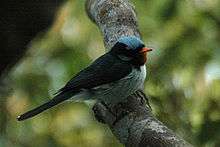Azure-crested flycatcher
The azure-crested flycatcher or blue-crested flycatcher (Myiagra azureocapilla) is a species of bird in the monarch flycatcher family Monarchidae. It is endemic to Fiji, where it is found on Taveuni.
| Azure-crested flycatcher | |
|---|---|
 | |
| Scientific classification | |
| Kingdom: | Animalia |
| Phylum: | Chordata |
| Class: | Aves |
| Order: | Passeriformes |
| Family: | Monarchidae |
| Genus: | Myiagra |
| Species: | M. azureocapilla |
| Binomial name | |
| Myiagra azureocapilla Layard, 1875 | |
Its natural habitats are subtropical or tropical moist lowland forests and subtropical or tropical moist montane forests.
Taxonomy
The azure-crested flycatcher was first described in 1875 by ornithologist Edgar Leopold Layard, Administrator of the Government of the Colony of Fiji at the time.[2] Its specific epithet is derived from the Latin azureus 'blue', and capillus 'of the head'.[3] It is also commonly known as the blue-crested broadbill,[4] or the azure-crested flycatcher.
It is a member of a group of birds termed monarch flycatchers. This group is considered either as a subfamily Monarchinae, together with the fantails as part of the drongo family Dicruridae,[5] or as a family Monarchidae in its own right.[6] They are not closely related to their namesakes either, the Old World flycatchers of the family Muscicapidae; early molecular research in the late 1980s and early 1990s revealed the monarchs belong to a large group of mainly Australasian birds known as the Corvida parvorder comprising many tropical and Australian passerines.[7] More recently, the grouping has been refined somewhat as the monarchs have been classified in a 'Core corvine' group with the crows and ravens, shrikes, birds of paradise, fantails, drongos and mudnest builders.[8]
In 2016, two former subspecies of the azure-crested flycatcher were reclassified as a separate species, the chestnut-throated flycatcher.[9]
Description
Measuring 14 cm (5.5 in) in length, the azure-crested Flycatcher is sexually dimorphic. The male has light blue crown with slate-blue upperparts, and white underparts. The female in brown above with greyish tinged cheeks and bluish tinged crown.[4] Unusually for the genus Myiagra the bill is bright orange instead of black.
References
- BirdLife International (2016). "Myiagra azureocapilla". IUCN Red List of Threatened Species. 2016: e.T103711173A94121418. doi:10.2305/IUCN.UK.2016-3.RLTS.T103711173A94121418.en.
- Layard EL (October 1875). "Description of a new Flycatcher belonging to the Genus Myiagra, and Notes a some other Fijian Birds". Ibis. 17 (4): 434–36. doi:10.1111/j.1474-919X.1875.tb05993.x.
- Simpson DP (1979). Cassell's Latin Dictionary (5th ed.). London: Cassell Ltd. p. 883. ISBN 0-304-52257-0.
- Mercer, Robin (1967). A Field Guide to Fiji Birds. Suva: Government Press. p. 21.
- Christidis L, Boles WE (1994). The Taxonomy and Species of Birds of Australia and its Territories. Melbourne: RAOU.
- Christidis L, Boles WE (2008). Systematics and Taxonomy of Australian Birds. Canberra: CSIRO Publishing. pp. 174. ISBN 978-0-643-06511-6.
- Sibley, Charles Gald & Ahlquist, Jon Edward (1990): Phylogeny and classification of birds. Yale University Press, New Haven, Conn.
- Cracraft J, Barker FK, Braun M, Harshman J, Dyke GJ, Feinstein J, Stanley S, Cibois A, Schikler P, Beresford P, García-Moreno J, Sorenson MD, Yuri T, Mindell DP (2004). "Phylogenetic relationships among modern birds (Neornithes): toward an avian tree of life". In Cracraft J, Donoghue MJ (eds.). Assembling the tree of life. New York: Oxford Univ. Press. pp. 468–89. ISBN 0-19-517234-5.
- "Species Updates « IOC World Bird List". www.worldbirdnames.org. Retrieved 2016-11-01.
| Wikimedia Commons has media related to Myiagra azureocapilla. |
| Wikispecies has information related to Myiagra azureocapilla |
